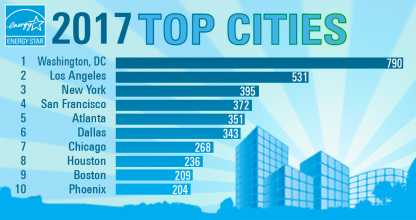by Brianna Crandall — June 28, 2017 — The U.S. Environmental Protection Agency (EPA) just unveiled this year’s ENERGY STAR Top Cities list, showing which U.S. metro areas were home to the most ENERGY STAR-certified buildings last year. EPA ranked the Top 25 Cities overall, the Top 10 Mid-Size Cities, and the Top 10 Small Cities.

Washington, DC, held its lead for the third year over second-place Los Angeles, which topped the list the first six years; New York City made its first appearance among the top three.
Highlights:
- For the third year in a row, Washington, DC, held its lead over second-place Los Angeles, which dominated the list for the first six years of the rankings.
- A record 790 buildings were certified in the DC area in 2016.
- Third-place New York has continued its steady rise in the rankings, starting out in 12th place and now making its first appearance among the top three.
- San Francisco and Atlanta earned fourth and fifth place, respectively, each with more than 350 ENERGY STAR-certified buildings.
- Kentucky cities dominated the list of Top Small Cities, accounting for a full six of the 10 top-ranked cities
- More than 30,000 diverse buildings have earned the ENERGY STAR since 1999. Together, they have saved more than $4 billion on utility bills and helped achieve broad emission reductions — including greenhouse gas emissions equal to the annual electricity use of nearly 3 million homes.
Help your metro area improve its ranking
EPA points out that many cities are separated by only a few buildings, so the agency you can actually make a difference by earning the ENERGY STAR for one or more of your buildings this year. Plus EPA says it sends mayors’ offices a list of all the certified buildings in their region every year, bringing high-performing facilities additional recognition.
The ENERGY STAR site notes these current trends in energy efficiency:
“We’re continuing to see a significant increase in the use of LED lighting. First it was used in areas like parking garages, but as prices have come down we’re seeing more interior LED retrofits, as well.
“On the high-tech side, we’re also seeing more building automation systems. Put simply, these systems make a building smart. You can program all your equipment to go on and off at certain times. You can also remotely monitor and control your equipment from off-site. This is similar to smartphone apps for homes, where you can turn the lights on and off and set the thermostat while you’re away.
“Additionally, we’re seeing a huge increase in the availability of energy use data, including real-time data in 15-minute intervals. Facility managers used to have to wait until the monthly bill came before they realized there was a problem. Now they can see variations in energy use almost immediately, which makes it easier to identify, find, and fix problems.”
See the complete rankings and statistics for the 2017 ENERGY STAR Top 25 Cities, Top Mid-Size Cities and Top Small Cities on the ENERGY STAR Web site. For further information, see these pages as well: How to apply for ENERGY STAR certification, Buildings and Plants, Portfolio Manager, and Tools and Resources.





